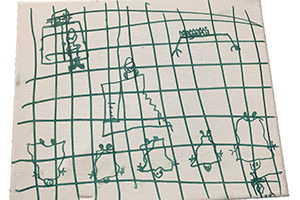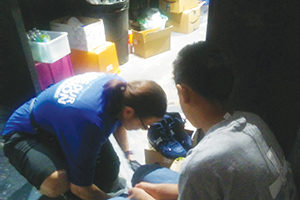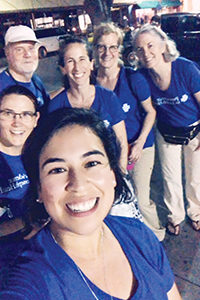Providence volunteers lend empathy and elbow grease to immigrant respite center
August 1, 2019 from Catholic Health Association of the United States
Providence volunteers lend empathy and elbow grease to immigrant respite center
Catholic Charities says volunteers are vital to meet the crushing demand for services near the border
Carrie Schonwald says that she had braced herself for what she would see as a volunteer at a respite center on the Texas border helping with the recent surge in immigrants.
Even so, she was overwhelmed by the seeming chaos and confusion as families sought desperately needed aid at the center run by Catholic Charities of the Rio Grande Valley. “It was just a real mass of people,” Schonwald says.
The chaos was no doubt exacerbated by the center’s relocation days earlier. But even in the best of circumstances the swell of hungry, disheveled and traumatized migrants coming into the Catholic Charities refugee center in McAllen for help in mid-June would have stretched its staff and resources beyond their limits.
At the time, the center was each day assisting upwards of 1,000 people who were recently released from detention centers and in need of food, a change of clothing and aid making their way to the homes of relatives already living in the United States.
Schonwald led a team of six from Renton, Wash.-based Providence St. Joseph Health to help the center’s staffers and local volunteers — people she refers to as “superheroes” — respond to the refugee surge.

photo: After being released from a detention center along the U.S. border with Mexico, a migrant child drew this picture of people sleeping behind bars. The photo of the drawing was one of several such images shared by the American Academy of Pediatrics to draw attention to the emotional toll of detention on children.
Kindness to spare
Amid the confusion, the contingent from Providence found their bearings. They spent the week doing chores that included serving meals; distributing clothing; buying supplies for, prepping and filling snack bags with bottles of water and ham-and-cheese sandwiches; and directing refugees to the buses and airplanes that would carry them on the next leg of a long journey that for most had started thousands of miles away in Central America.
One volunteer, a Providence executive who doesn’t speak Spanish, made scrubbing the women’s showers a personal mission so each refugee could wash in a clean stall. That same woman became the go-to person for single fathers to hand off their young daughters for showers. Afterward, she braided many of the little girls’ hair in long plaits that became a signature gesture.”It was like a sacred act,” Schonwald says. “It was like a ministry. It was just one person. It was just her.”
Another member of the Providence team is a nurse practitioner. She hadn’t gone to Texas as a clinical volunteer, but with the respite center’s own clinic out of commission at the time, she spent long days providing minor medical care and directing people with more acute concerns to medical centers.
Another team member took it upon himself to help bring some organization to the center by taping out pathways to the various stations to help with the lines.
“And then when he went to buy rope to organize those lines he realized they could also be used for jump rope and for the last days, in a space that the center had been able to clear out, he cut a huge jump rope and he played jump rope for two or three hours a day with all the kids there,” Schonwald says. “And you heard laughing and joy and you saw smiles on those little faces.”

photo: Susan Tuller washes the feet of 12-year-old Mario at a respite center in McAllen, Texas, run by Catholic Charities of the Rio Grande Valley. Tuller was among a team of Providence St. Joseph Health volunteers who spent a week helping refugees at the center in June. Mario had walked with his mother from El Salvador and in the last two weeks of their journey, did so with shoes that were in shreds. As a result, his feet were rubbed raw. Tuller found him a new sturdy pair of sneakers and the softest socks available.
Compassion and respect
Gladys Rivera, one of the team members, says that even the small kindnesses, like flashing a smile to an overwhelmed mother or fixing a batch of tortillas for hungry families, were met with intense gratitude.
“I know that I and we all made a difference down there by just treating people with compassion, respect and dignity,” says Rivera, a program coordinator for Providence Hood River Memorial Hospital in Hood River, Ore. “And I know that we will all in different ways be part of their story.”
Schonwald, manager of international educational exchanges for Providence, has done a lot of volunteering, including working with survivors of human trafficking in the U.S. and helping with economic development projects in Guatemala. She says the scale of the need and the heartfelt response she saw in McAllen touched her deeply.
“I think anyone who goes there will feel that it was a life-changing experience,” she says.
Root causes
As to the small team of Catholic Charities workers and volunteers who staff the respite center on a permanent basis, Schonwald sees them as almost saintlike for being there daily to help poor and vulnerable refugees who have only strangers to rely on as they take their first tentative steps toward what could be their dream of a new life.
Leading that band of caregivers is Sr. Norma Pimentel, MJ, executive director for Catholic Charities of the Rio Grande Valley. Sr. Pimentel has spent decades helping immigrants and has overseen the agency’s refugee efforts since 2014.
She says while the recent surge in refugees is historic, the motivation behind their risky journeys remains the same: many are fleeing the misery of unrelenting poverty or the threat of deadly violence.
Sr. Pimentel says that in the first half of July, the number of immigrants seeking help at the respite center dropped to 500 to 600 daily — a level that still puts great demands on the center’s limited resources.
She is grateful for the outpouring of service and donations that Catholic communities across the country have provided to further the center’s mission of giving the migrants what she sees as “the basic things that a human person needs just to be able to restore their dignity and make them feel like persons again.”
While funds are necessary to keep the center’s lights on and showers running and to buy the supplies to feed and clothe the refugees, Sr. Pimentel says the volunteers are vital to keep it in operation and to bear witness to the magnitude of the need.
“It’s so beautiful to see our church, our people, involved and willing to participate in our response,” she says. “It’s what we are: one family, one community, one church.”
Bearing witness
Aimee Khuu, system director of global partnerships at Providence, issued the call for volunteers from that system after reading in the CHA Weekly emailthat Catholic Charities sought help at the border. She says that within 24 hours of asking for employees willing to head south within a few weeks, she had a full slate of volunteers.
The response didn’t surprise her.

photo: Volunteers from Providence who helped out at a Catholic Charities migrant respite center are Gladys Rivera, front, program coordinator, Providence Hood River; and, from left in back, Susan Tuller, executive director of Providence ElderPlace; Patrick Rawson, spiritual care chaplain at Providence Hood River; Carrie Schonwald, manager of international educational exchanges for Providence; Sue Giboney, chief patient experience officer; and Becki Rawson, orthopedic nurse practitioner.
 “I think that people know that what’s happening along the border is wrong and they want to do something, and they don’t know what to do,” Khuu says. “This was an opportunity for them to respond.”
“I think that people know that what’s happening along the border is wrong and they want to do something, and they don’t know what to do,” Khuu says. “This was an opportunity for them to respond.”
Khuu’s own family were refugees from Vietnam, and she remembers how Catholic parishes sponsored many Vietnamese families and helped them resettle in the United States. She is hopeful that churches and other institutions will step up now to embrace the refugees crossing the southern border.
“Hearing the stories of migrants and meeting someone who has had to flee a dangerous situation allows us to be sensitized and to humanize a very political issue in our communities,” Khuu says.
…………………………………………………………………………………………..
In migrant children’s drawings, stark reality and indomitable hope
The drawings are grim. They depict stick figures standing behind bars while others with hats and what appear to be gun belts stand at desks outside the bars, people sleeping on the floor of what looks like a huge cage, and toilets and a shower behind bars.
The drawings by children who had been held in immigrant detention facilities on the Texas border have gotten national media coverage since they were shared by the American Academy of Pediatrics after pediatricians who toured some of the centers denounced them as unhealthy and dangerous places to house refugee children.
There are even reports that the Smithsonian Institution is interested in acquiring the drawings for its collection, although in a statement the institution says that an inquiry made about the drawings was only “part of an exploratory process.”
The drawings were done by children at the refugee respite center in McAllen, Texas, run by Catholic Charities of the Rio Grande Valley. Its executive director, Sr. Norma Pimentel, MJ, says she understands why the art has struck a chord with some people and been cited as evidence of the harsh impact detention can have on children.
But she says those drawings are not the whole picture when it comes to migrant children’s experience. Other drawings kept at the respite center depict a more joyous outlook with colorful hearts and houses.
She sees the happy pictures as evidence of the children’s resilience.
“To limit only to those dark pictures of their experience is to reflect one aspect only and in truth I see life and I see hope in the faces of the children once we give them a chance to laugh, to draw, to paint, and to have fun,” Sr. Pimentel says.
…………………………………………………………………………………………………
Appropriate giving: Avoiding a ‘disaster after a disaster’
It’s natural for people to want to help out after seeing searing images of a humanitarian crisis, like the one that has unfolded for months as refugees fleeing violence and poverty stream across the southern border into the United States.
But those who are familiar with dealing with such massive crises say that impulse should be tempered to ensure that what is given will, in fact, be helpful.
Bruce Compton, CHA’s senior director of international outreach, says that a general rule of thumb is that the request for specific aid should come from the people at ground zero.
“We usually tell people not to just send things and there’s not typically a fixed list of needed items that can be put out there unless you’re in communication with the organizations that are actually receiving these items, because those needs change so quickly,” Compton says.
He says good-intentioned but unhelpful giving can even cause what some experts on emergency relief refer to as the “disaster after the disaster.” That happens when supplies such as used clothing or perishable foods are more burden than aid.
Catholic Charities of the Rio Grande Valley, which is helping care for refugees released from detention centers on the Texas border, has a specific section about donations on its website: catholiccharitiesrgv.org/Donations.aspx. It includes a link to an Amazon wish list. To donate through Catholic Charities USA, visit catholiccharitiesusa.org/border-crisis/.
The agency’s executive director in the Rio Grande Valley, Sr. Norma Pimentel, MJ, says that in addition to money and specific material gifts, volunteer service is much needed and welcomed.
— LISA EISENHAUER



